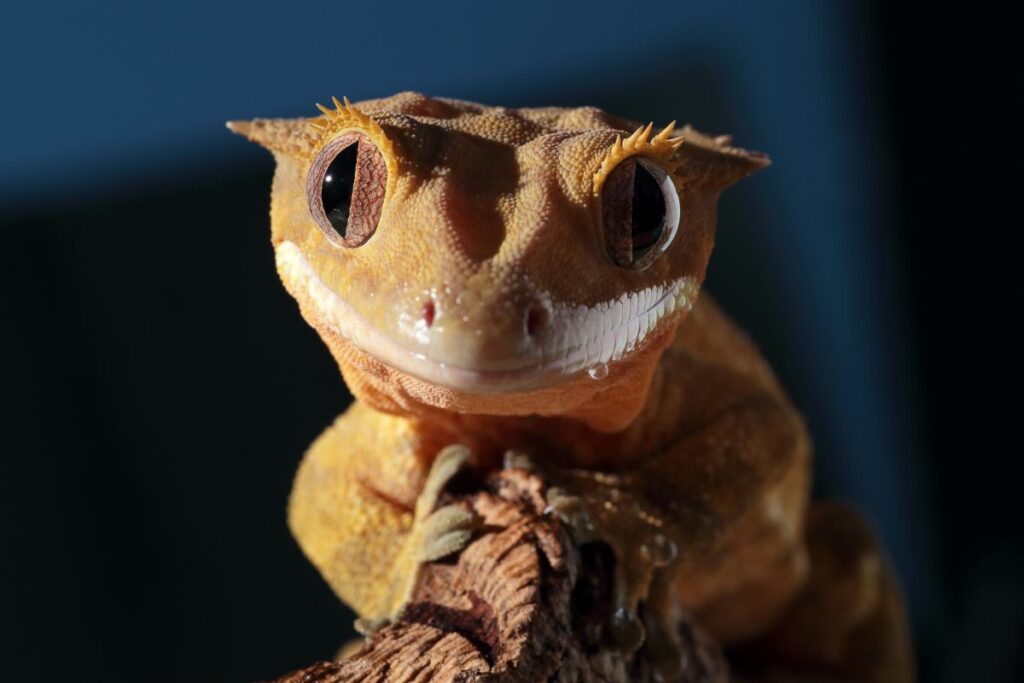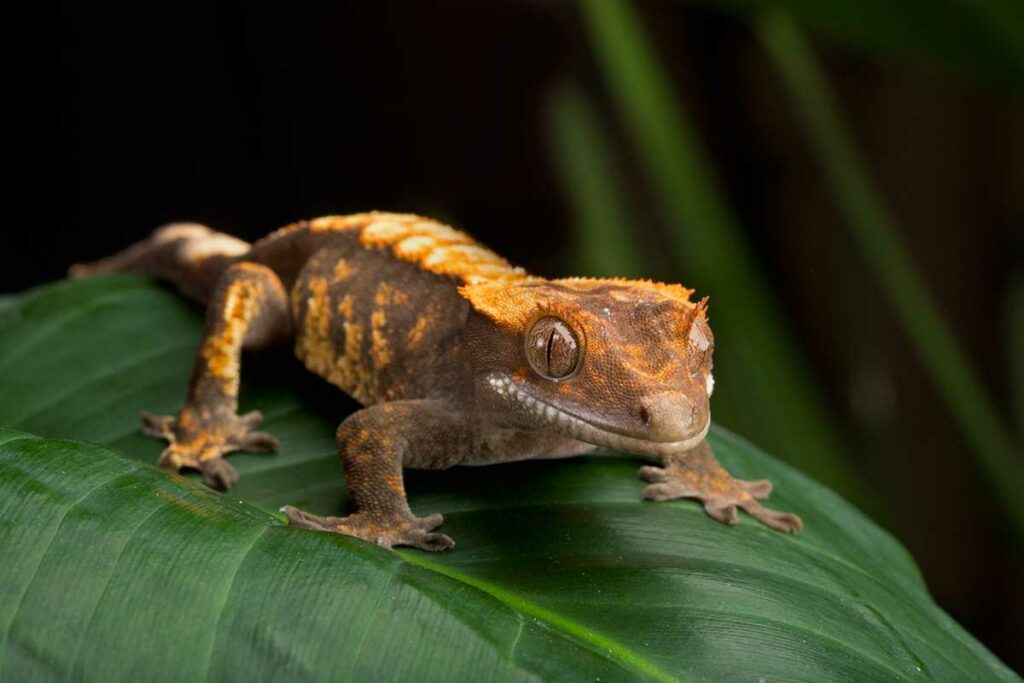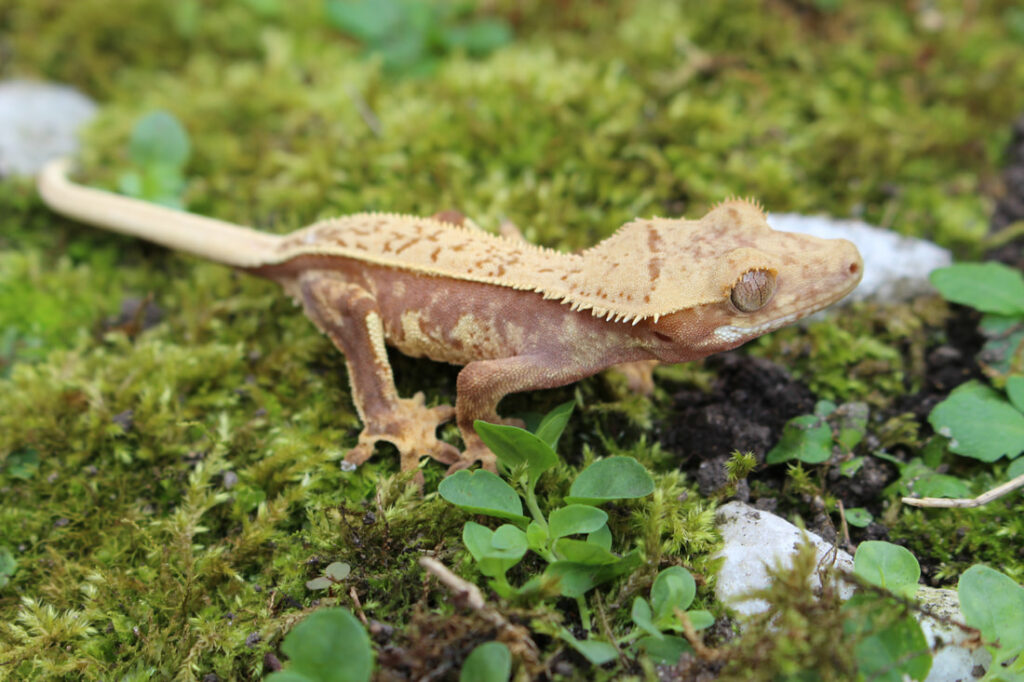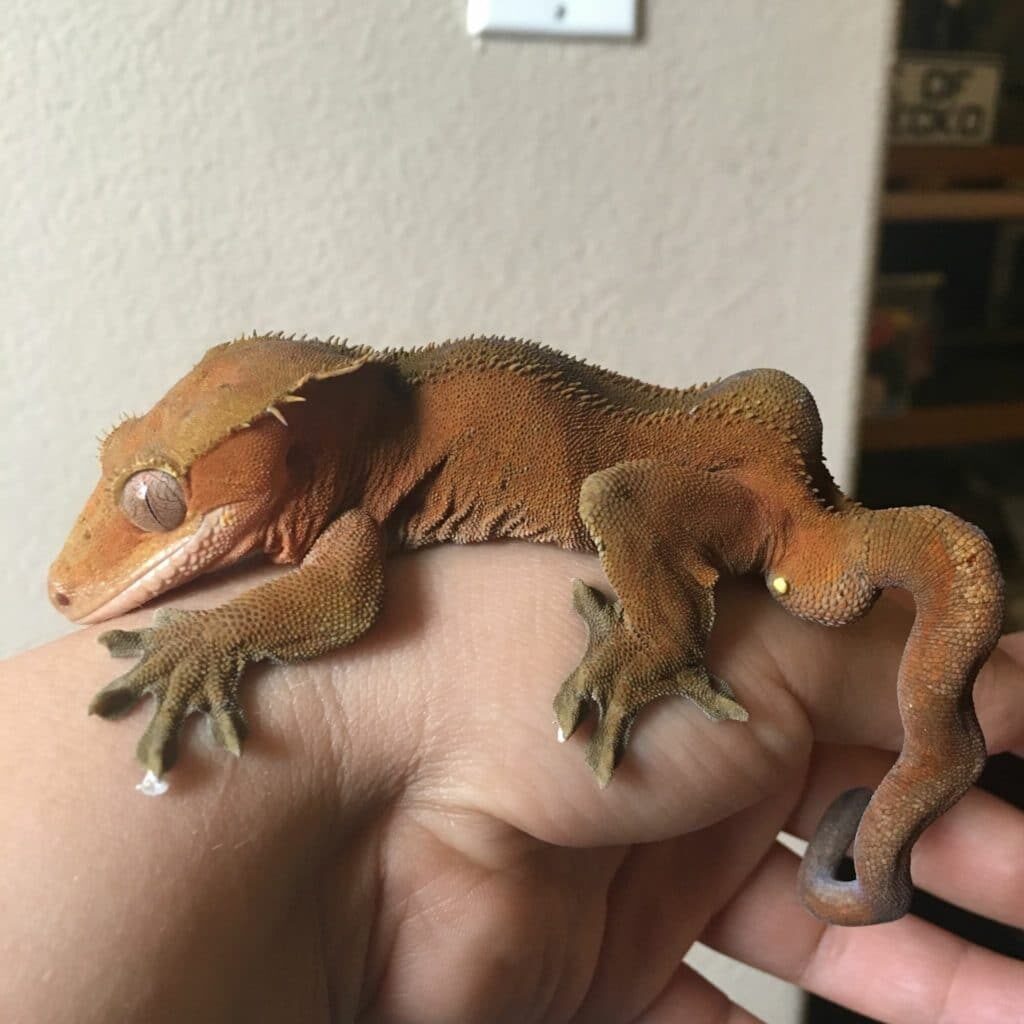The large, nocturnal eyes, soft skin, and cute face of a crested gecko are hard to resist when seen in person. What’s more, these lizards are affordable and easy to house. Crested geckos are one of the best beginner lizards for folks who want to start out with something more unique than an anole or bearded dragon.

What are Crested Geckos?
The crested gecko is a species of nocturnal lizard found on one island: New Caledonia, located off the coast of Eastern Australia. And even on this smallish island, they are found just on the southern tip.
There are several animals from this island that are of interest to reptile hobbyists. Including a few other species of gecko like the leachie gecko (Rhacodactylus leachianus) and gargoyle gecko (Rhacodactylus auriculatus). But the crested gecko is by far the most popular.
One of the first things people notice when examining a New Caledonian crested gecko are their adhesive pads. Most geckos have these, though some ground dwellers like leopard geckos do not. They attach to branches, glass, and even your skin.
These pads aren’t sticky. They exploit weak molecular attractive forces, giving them a grip just strong enough for their light bodies. Crested geckos also have a pad at the tip of their semi-prehensile tails.
Even though they are found in a small area of the world, crested geckos are very diverse in appearance. Which allows breeders to provide hobbyists with all sorts of cryptic and bold colored lizards.
You won’t see a wild crested gecko in the hobby; they are all captive bred these days. They are a vulnerable species in New Caledonia and are protected from collection or export. Fortunately, they have done very well in captivity and breed with ease.
- Common Names: Crested Gecko, Eyelash Gecko, New Caledonia Crested Gecko
- Scientific Name: Correlophus ciliatus
- Origin: New Caledonia
- Length: 7 to 9 inches
- Habitat Size: 20+ gallon tank
- Crested Gecko Lifespan: 15 to 20 years
- Ease of Care: Very Easy
Crested Gecko Care Sheet
Crested geckos are popular because they have very reasonable care requirements. They don’t need expensive light setups and eat a prepared blend of powdered food. Crested geckos also do well with handling and almost never bite.

Designing a Crested Gecko Setup
Crested gecko husbandry starts with the tank setup. The tank size should be at a minimum, 20 gallons. If you want to keep more than one, then add 10 gallons of space per extra adult lizard.
Tanks with a vertical layout are better since this is a tree climbing species. Branches and plants are the best decorations. In fact, live plants and crested geckos mix very well. Plants transpire water into the air as well, helping to maintain the right humidity for your lizards.
If you do keep live plants in your crested gecko terrarium then you will need a grow light. The light should have a spectrum of photosynthetically active radiation (PAR).
Not all lights do, so choose one that’s rated for plant growth. LED PAR lights are long-lasting, energy efficient, and don’t emit much waste heat.
Crested Gecko Lighting and Humidity Requirements
One of the best aspects to setting up a crested gecko tank is that these lizards don’t need basking or ultraviolet lighting.
They are nocturnal and don’t spend time out in the sun. Air temperatures of 74-78℉ are enough for them during the day. With cooler room temperature conditions (64-72℉) in the evening.
To heat a crested gecko setup you should use heat tape, heating pads, or ceramic fixtures. All of these work – but set them to a thermostat measuring the ambient air temperature.
Keeping eyelash geckos too warm is one easy way to kill them. They don’t need to bask like most reptiles. Part of the tank should also be cooler and located away from the heat source so the lizard can thermoregulate.
Monitoring humidity is important for a crested gecko pet. 60% to 75% should be maintained at all times. A hygrometer allows you to measure humidity levels at a glance.
Improper humidity is the second way people sometimes kill a crested gecko. Either by not misting enough – or by misting so often that the enclosure is dripping inside.
You may be able to mist once or twice per day and achieve 60% to 75% humidity. But if you live in a dry part of the world, an automatic mister will do a better job.
Misting is an important source of water for them as well. Crested geckos drink droplets of moisture from tree leaves and vines. They will drink from a water bowl and a small one should be provided. A water dish also helps keep humidity levels constant.
Crested geckos also need moderate air flow; they are prone to respiratory infections if kept in stagnant air. At least one side of the tank should be screen or mesh. Glass is fine for the other sides, however.
Substrate for Eyelash Crested Geckos

The substrate you choose should hold moisture well. Coco coir, peat moss, sphagnum moss, soil, or a blend of these are good choices. Soil gives support and nutrition if you want to grow live plants.
Bioactive substrates are great for crested gecko tanks. A mixture of the above, plus beneficial bacteria, fungi, and small invertebrates like isopods and springtails will do a lot of your maintenance for you.
They feed on the leftovers and droppings of your lizard. And provide a rich foundation for live plant growth.
Crested Gecko Diet
One of the best aspects to created gecko care is the diet. Prepared food blends are available in any pet store that caters to reptiles. It comes in a powder that is mixed with water.
It’s convenient, has all of the nutrients they need, and it’s easy to prepare. Crested gecko feeding is great for people that don’t want feeder insects in their house. They should be fed 3 times per week.
Try offering insects once in a while for nutritional diversity. Some crested geckos eat them while others will not. Crickets, silkworms, dubia roaches, and waxworms are the best. They should also be dusted with a calcium and vitamin D3 powder blend right before feeding.
Fresh fruit should also be offered. Stick to soft fruit like ripe bananas, papaya, or mango. You can also blend harder fruit into a soft smoothie for your crested geckos.
Handling Crested Geckos

Since all crested geckos in the hobby are captive-bred they are used to humans being around. It’s unfortunate, but geckos tend to be fast, bitey lizards that are stressed with handling. Even some that are common in the trade, like tokay geckos, never calm down.
Crested geckos are an exception. They do have their own personalities; some are calm and want to just hang out. While others are explorers and may wriggle if you try to keep them in place. But they are one of the few lizards that don’t just tolerate handling; they seem to enjoy it.
A crested gecko will jump at times. They don’t leap far and their adhesive toes give them instant grip. But a long fall will hurt them so keep your hands near your body or a piece of furniture. That way the lizard has an easy time grabbing hold.
Also make sure you’re careful with their tails. Like all geckos, they drop them as a defense against predators. Rough handling will also cause them to lose the tail. Their tails don’t grow back if dropped.
It won’t cause the gecko lifelong stress if it loses its tail. But it does lose the ability to grasp tree branches with it as a fifth limb.
Conclusion
Crested gecko care is as easy to care for as it gets for a pet reptile. They don’t need expensive and complex lighting setups. And they eat a prepared formula based diet. As long as you maintain their humidity at the right level, you will enjoy your crested gecko for years to come.
FAQs
Crested geckos are nocturnal lizards. Their enclosure should have a day/night cycle using low power lights. But they don’t need infrared (heat) or ultraviolet lighting to thermoregulate.
For small lizards, crested geckos are very long lived. Assuming you meet all of their care needs, they will live 15 to 20 years.
Crested geckos are found on the island of New Caledonia, off the coast of Australia. Since they are found in just one region of the world, they are considered an endemic species. Crested geckos are vulnerable to extinction as a result.
Yes, you can. Provide 10 gallons of extra space per lizard. And only keep one male per enclosure. Females are sociable and will live together in harmony. But males are territorial and will fight.
